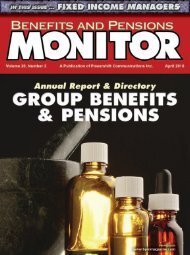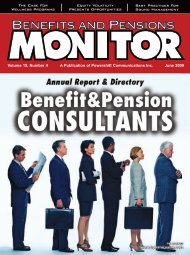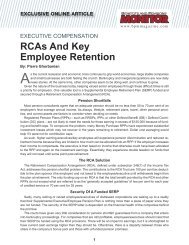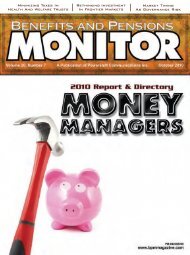April - Benefits and Pensions Monitor
April - Benefits and Pensions Monitor
April - Benefits and Pensions Monitor
Create successful ePaper yourself
Turn your PDF publications into a flip-book with our unique Google optimized e-Paper software.
Dear Plan Sponsor,<br />
Marret Asset Management Inc. is an employee-owned firm specializing in the analysis of higher<br />
yielding corporate securities. The firm was founded in 2000 in Toronto <strong>and</strong> accepted its first<br />
pension account in 2001.<br />
Non-investment grade corporate debt is a separate <strong>and</strong> distinct asset class with a unique return,<br />
risk <strong>and</strong> correlation profile. We believe that the only viable model for investing in high yield<br />
corporate debt is to do it full-time. The intricacies of the asset class dem<strong>and</strong> a dedicated team of<br />
analysts. Marret has the largest high yield team <strong>and</strong> a depth of experience that is unrivalled in<br />
Canada. We invest in the bonds of operating companies across all industries <strong>and</strong> our analysts<br />
focus on specific industry sectors in which they have expertise.<br />
For investors considering tactical allocations to the asset class, we think the current environment<br />
is setting-up a unique entry point. High yield credit spreads, using the Merrill Lynch High Yield<br />
Master II index, peaked at 2,182 basis points over Treasuries on December 15, 2008. The 1,941<br />
basis point widening from the historic tights of 241 basis points on June 5, 2007 was<br />
unprecedented (as were many things this cycle). In prior recessions, high yield spreads peaked at<br />
1,000 to 1,100 basis points.<br />
On the risk side of the equation, the speculative grade default rate, as measured by Moody’s<br />
Investors Services, was 5.15% in January, but is moving quickly towards prior recessionary<br />
peaks of 12-13%. Depending on recovery assumptions (which we think have to be much lower<br />
this cycle) current spreads are discounting much higher losses – nearly twice that experienced<br />
during the Great Depression. We believe that current spreads reflect an enormous liquidity<br />
premium due to massive de-leveraging of the financial system <strong>and</strong> will lead to the highest returns<br />
ever, both absolute <strong>and</strong> risk adjusted.<br />
High yield is an early cycle asset class. In the first two years coming out of the last three<br />
recessions, the compound annual return of the Merrill Lynch High Yield Master II index has<br />
h<strong>and</strong>ily beaten or matched the return of the S&P 500. The first year out of recession, including<br />
2003, typically has an index return in the 25% to 30% range. The turmoil of today, while not yet<br />
over, is the lead in to this type of return for the asset class.<br />
If you would like more information, please contact me at 416-214-5800.<br />
Best Regards,<br />
Barry Allan,<br />
President & Chief Investment Officer<br />
150 King Street West, Suite 2304, P.O. Box 22, Toronto, Ontario, M5H 1J9









